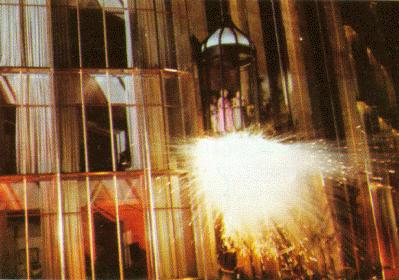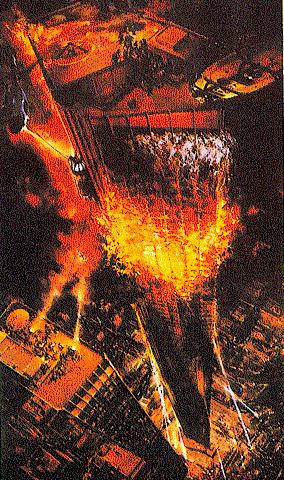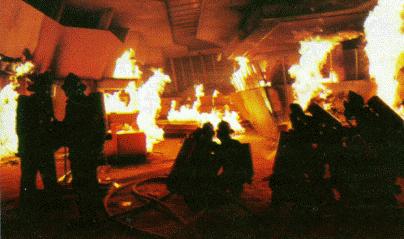 PRODUCTION
PRODUCTION
The information available here comes from original documents, published at the time "THE TOWERING INFERNO" hit the cinemas. At this point you can choose articles from these 2 publications:

The Production (Article from the Warner Bros. press documents) Hollywood's cynical eye has been transformed into a popeyed stare of wonderment at the grandiose dimensions of Irwin Allen's $14-million production of "The Towering Inferno", an awesome suspense drama that places a galaxy of screen superstars inside the tallest skyscraper in the world and assaults them with a holocaust that beggars description its terrifying fury and spectacular dangers. Far and away the biggest motion picture of the 1974-75 season, "The Towering Inferno" also marks a Hollywood innovation that establishes a new concept in film production. For the first time two major studios, Warner Bros. and 20th Century-Fox, have become full partners to bring a story to the screen as a joint venture. Even the immortal "Grand Hotel" of 42 years ago, with its Barrymores and Crawford and Garbo and Beery, would find itself pressed to compete with the all-star lineup in "The Towering Inferno", highlighted by the presence of such as Steve McQueen, Paul Newman, William Holden, Faye Dunaway, Fred Astaire, Susan Blakely, Richard Chanberlain, Jennifer Jones, O.J. Simpson, Robert Vaughn and Robert Wagner. But size and importance were an inherent quality in "The Towering Inferno", which John Guillermin directed with Irwin Allen directing the action sequences. Its 57 sets established a record for a single film on the 20th Century-Fox lot. So did its four complete camera crews, shooting simultaneously to bring the exciting drama to fruition. Eight of the studio's largest sound stages were filled with sets for the film, and its crew was increased to more than twice the normal number to meet the demands of the rigorous shooting schedule. Even the suspenseful story was devised from two novels as screenwriter Stirling Silliphant adapted the script from Richard Martin Stern's "The Tower" and "The Glass Inferno" by Frank Robinson and Tom Scortia.  "Actually, it was the amazing similarity of the two novels that brought about the marriage of two major studios to
co-sponsor the film," producer Irwin Allen revealed. "Both were concerned with high-rise fires in unusually identical
circumstances. We all felt it would have been foolhardy to compete in a race to beat each other to the boxoffice with the
same movie, so we formed an amalgamation to create a single blockbuster script from the two books and to share the
costs and the rewards. It was a sensible solution and I'm quite sure it is the first of many future films to be created in
tandem by major companies." "Actually, it was the amazing similarity of the two novels that brought about the marriage of two major studios to
co-sponsor the film," producer Irwin Allen revealed. "Both were concerned with high-rise fires in unusually identical
circumstances. We all felt it would have been foolhardy to compete in a race to beat each other to the boxoffice with the
same movie, so we formed an amalgamation to create a single blockbuster script from the two books and to share the
costs and the rewards. It was a sensible solution and I'm quite sure it is the first of many future films to be created in
tandem by major companies."
Many of those who helped turn Irwin Allen's production of "The Poseidon Adventure" into one of the most successful motion pictures of all time with its global gross now approaching the $160-million mark, are on his team of experts again for "The Towering Inferno". Sidney Marshall again served as associate producer and Al Gail was executive assistant to the producer. Hal Herman and Norman Cook served as production managers. Stirling Silliphant wrote the screenplay, William Creber was production designer with Ward Preston as art director and Raphael Bretton as set decorator. Herman Lewis handled sound, Paul Zastupnevich designed the costumes. Paul Stader supervised the stunt scenes, A.D. Flowers supervised the mechanical effects and L.B. Abbott handled special photographic effects. More than fifty additional crew members were also part of the team that turned "The Poseidon Adventure" into one of the top boxoffice hits in Hollywood's history. Creating the world's tallest skyscraper that stretches 138 stories above ground to dominate the skyline of San Francisco was a monumental task, to say the least. Because the Glass Tower is a building of the future, its architectural innovations are as startling as its dimensions; the structure is a golden monolith of glass and metal that has no counterpart in the world today. The interiors, dominated by eye-catching geometrical patterns and designs, feature many of the architectural ideas and plans of tomorrow. Interior furnishings are both contemporary and futuristic. Many components were joined together to form the Glass Tower on the screen. At Fox' former Malibu Ranch, five floors of the skyscraper were duplicated in full size for closer camera work. High-rise buildings in the heart of San Francisco doubled as the Glass Tower's exterior mall and inner lobby during a three-week location stay in the city by the bay. The basement of a Century City office building, with its consoles and panels of electronic controls and check systems, also served as an important setting. A record-breaking four complete camera crews worked simultaneously to create "The Towering Inferno". John Guillermin directed the cast unit, Irwin Allen directed the action sequences, Jim Freeman headed an aerial crew filming air-to-air and air-to-ground sequences, and Bill Abbott supervised the special photographic effects crew developing the "movie magic" necessary for the story. The most impressive set in "The Towering Inferno" was the skyscraper's roof garden area, the Promenade Deck, which was entirely destroyed before filming was completed. The set, one and a half times larger than the replica of the capsized ocean liner built for "The Poseidon Adventure", covered more than 11,000 square feet of sound stage area, its many levels raised from six to twelve feet above the stage floor and towering an additional 25 feet upwards. A 340-foot cyclorama showing the world-famous San Francisco skyline encircled the huge set that also featured trees, shrubbery, fountains and a delightful promenade area around the dining, drinking and dancing areas." In the single most awesome moment of the suspense drama, the Promenade Deck set and its occupants were assaulted by almost a million gallons of water dropped from a height of 40 feet to simulate the blasting of water storage tanks in an effort to quell the holocaust. 
More than 200 individual acts of cinematic danger were performed by the greatest collection of Hollywood stunt experts in film annals under the supervision of stunt coordinator Paul Stader. "In most films, if something goes wrong a stuntman would get hurt," Sader explains. "In The Towering Inferno, if something had gone wrong a stuntman could have been killed." It is a tribute to the overpowering drama of the high-rise holocaust that by the time filming was completed at the studio, only eight of the 57 sets were still intact. Quotes from the Warner Bross. press documents
|